Modulation of Excitability of Spinal Neural Functions by Acupoint Stimulation Physical Therapy at LU5 (Chize) in Three Hemiplegic Patients with Cerebrovascular Disease
Toshiaki Suzuki 1,2,* ![]() , Makiko Tani 1,2
, Makiko Tani 1,2 ![]() , Kaito Takamori 3
, Kaito Takamori 3 ![]() , Maki Yamada 3
, Maki Yamada 3 ![]()
- Graduate School of Kansai University of Health Sciences, Osaka, Japan
- Clinical Physical Therapy Laboratory, Faculty of Health Sciences, Kansai University of Health Sciences, Osaka, Japan
- Department of Rehabilitation, Rokujizo General Hospital, Kyoto, Japan
* Correspondence: Toshiaki Suzuki ![]()
Received: January 21, 2017 | Accepted: February 10, 2017 | Published: February 20, 2017
OBM ICM 2017, Volume 2, Issue 1, doi:10.21926/obm.icm.1701001
Academic Editor: Gerhard Litscher
Recommended citation: Suzuki T, Tani M, Takamori K, Yamada M. Modulation of Excitability of Spinal Neural Functions by Acupoint Stimulation Physical Therapy at LU5 (Chize) in Three Hemiplegic Patients with Cerebrovascular Disease. OBM ICM 2017;2(1):001; doi:10.21926/obm.icm.1701001.
© 2017 by the authors. This is an open access article distributed under the conditions of the Creative Commons by Attribution License, which permits unrestricted use, distribution, and reproduction in any medium or format, provided the original work is correctly cited.
Abstract
(1) Background: Acupoint stimulation physical therapy (ASPT) is a novel method of physical therapy that combines physical and acupuncture methods. This study aimed to examine the effect of ASPT in three hemiplegic patients with cerebrovascular disease using F-wave as a measure of the excitability of spinal neural function. (2) Methods: Subjects included three hemiplegic patients with cerebrovascular disease who presented with three types of neurological findings. All patients had moderate hypertonic muscles on the affected side. The grade of tendon hyperreflexia was slight, moderate, and severe. We applied inhibition ASPT on LU5 (Chize) for hypertonia of the thenar muscle on the affected side. The F-wave was measured before, during, and after ASPT and was analyzed as persistence, amplitude ratio of F/M, and latency.
(3) Results: The amplitude ratio of F/M gradually decreased during and after ASPT compared with that before ASPT. No significant differences in persistence and latency were found before, during, and after ASPT.(4) Conclusions: The inhibition ASPT method may be a therapeutic approach that decreases muscle tonus in patients with cerebrovascular disease.
Keywords
Acupoint stimulation physical therapy; F-wave; LU5 (Chize); cerebrovascular disease
Introduction
In cases of cervical dystonia, it is important to identify the affected muscles through clinical evaluation and electromyography findings derived from motion analysis. For the treatment of muscle tonus abnormalities, pre-sterilized disposable acupuncture needles (diameter, 0.2 mm; length, 50 mm) are inserted ipsilaterally into three acupoints selected on the basis of the meridian concept of typical distal acupoints along lines running through the affected muscles (Figure 1). These acupoints are LI4 (Hegu; on the dorsum of the hand, radial to the midpoint of the second metacarpal bone) for the affected sternocleidomastoid muscle, TE5 (Waiguan; on the posterior aspect of the forearm, at the midpoint of the interosseous space between the radius and the ulna, 2 B-cun proximal to the dorsal wrist crease) for the trapezius, and SI3 (Houxi; on the dorsum of the hand, in the depression proximal to the ulnar side of the fifth metacarpophalangeal joint, at the border between the red and white flesh) for the splenius muscle (SPL).
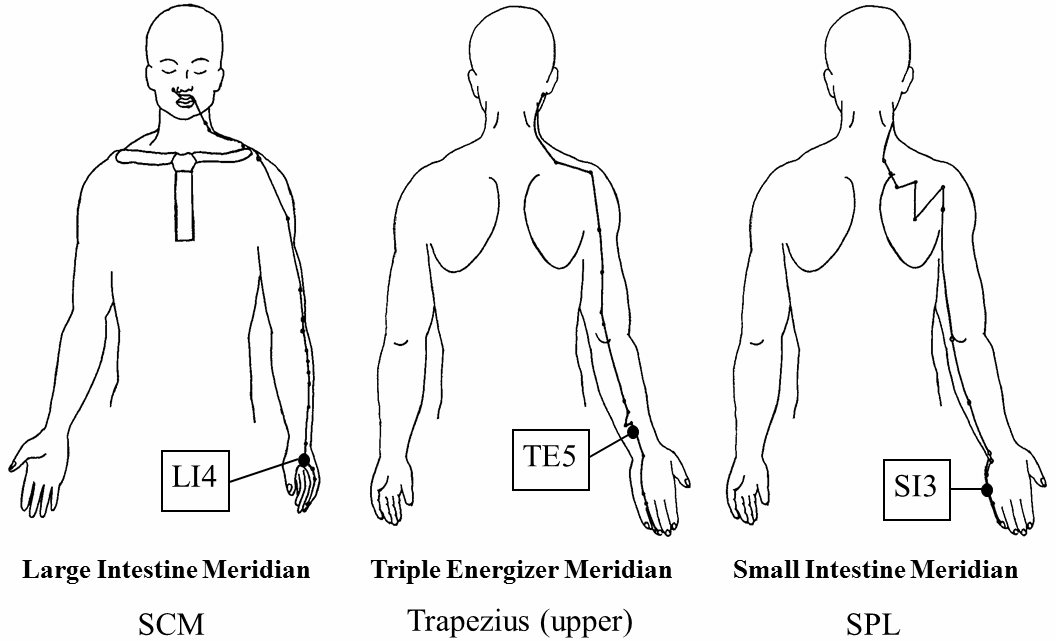
Figure 1 Relationship between affected muscles and acupoints.
Acupoints were LI4 for the affected sternocleidomastoid muscle (SCM), TE5 for the affected trapezius and SI3 for the affected splenius muscle (SPL).
Based on this, we developed the acupoint stimulation physical therapy (ASPT) technique as a novel concept in physical therapy (Figure 2) [1,2,3,4].
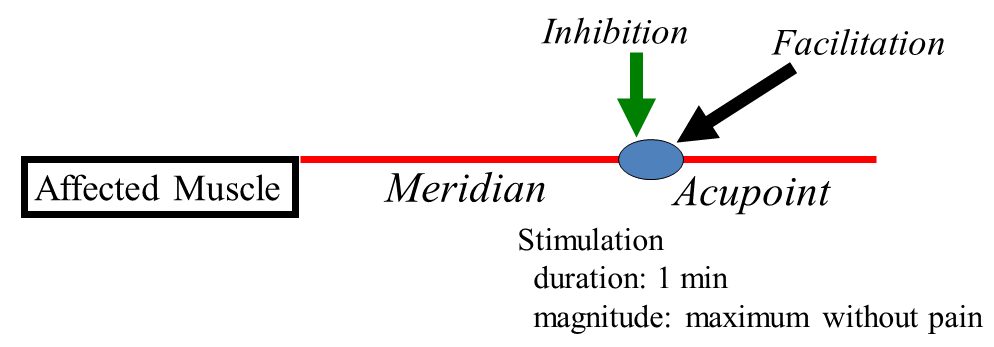
Figure 2 The method of acupoint stimulation physical therapy (ASPT).
The characteristics of ASPT are as follows: acupoints are pressed on the basis of the meridian concept of typical distal acupoints along the lines running through the affected muscles. Acupressure is applied at the maximum magnitude without pain and for the duration required to change the muscle tonus. Acupressure is applied vertically to decrease muscle tonus and obliquely to increase muscle tonus.
We previously reported the clinical effects of ASPT on flexion contracture of the knee joint in a patient with chronic hemiplegia secondary to cardiovascular disease [5]. The effects were investigated in terms of alterations in the range of motion (ROM) in the patient presenting with contracture in both knee joints and shortening of the hamstring muscles. We applied ASPT to either BL60 (Kunlun; on the posterolateral aspect of the ankle, in the depression between the prominence of the lateral malleolus and the calcaneal tendon) or KI3 (Taixi; on the posteromedial aspect of the ankle, in the depression between the prominence of the medial malleolus and the calcaneal tendon) to decrease the muscle tonus of the hamstring. We then monitored the effect by measuring ROM of the knee extension before and after applying ASPT. ASPT at BL60 (Kunlun) and KI3 (Taixi) caused decreased muscle tonus leading to significantly improved ROM of the knee extension.
In this study, we examined the effects of ASPT in hemiplegic patients with cerebrovascular disease using F-wave as a measure of excitability of spinal neural function.
Ethics Statement
This study was approved by the Research Ethics Committee at Kansai University of Health Sciences (Japan). The experiments were conducted in accordance with the Declaration of Helsinki.
Materials and Methods
Subjects comprised three hemiplegic patients with cerebrovascular disease and three types of neurological findings. All patients had difficulty in moving the thumb due to moderate hypertonia of the thenar muscles on the affected side; however, the grade of tendon hyperreflexia ranged from slight (Case 1), to moderate (Case 2) to severe (Case 3) judged according to the range and speed of tendon reflex.
Subjects were positioned comfortably in the supine position with sufficient freedom of movement to apply external rotation of both shoulder joints. Abrasive gel was applied to the skin to maintain an impedance of <5 kΩ. After stimulating the median nerve of the wrist at rest, the F-waves of the affected thenar muscles were recorded using the VIASYS Viking Quest electromyography system (Natus Medical Inc. CA, USA) via a pair of circular electrodes attached (with Collodion) to the skin over the abdomen and the bone of the metacarpophalangeal joint of the thumb. The stimulating electrodes comprised a cathode and an anode placed over the affected median nerve at 3 cm and 5 cm, respectively, proximal to the palmar crease of the wrist joint. The maximal stimulus was determined by delivering 0.2-ms square-wave pulses of increasing intensity to elicit the largest compound muscle action potentials. Supramaximal shocks (adjusted up to a value >20% higher than the maximal stimulus) were delivered at 0.5 Hz for the acquisition of F-waves. The bandwidth filter ranged from 2 to 3 kHz.
Next, we recorded the F-waves at 0 min (post 0), 5 min (post 5), 10 min (post 10), and 15 min (post 15) after the application of ASPT for 1 min at LU5 (Chize; on the anterior aspect of the elbow, at the cubital crease, in the depression lateral to the biceps brachii tendon) on the affected side, with maximal vertical pressure without pain (Figure 3).
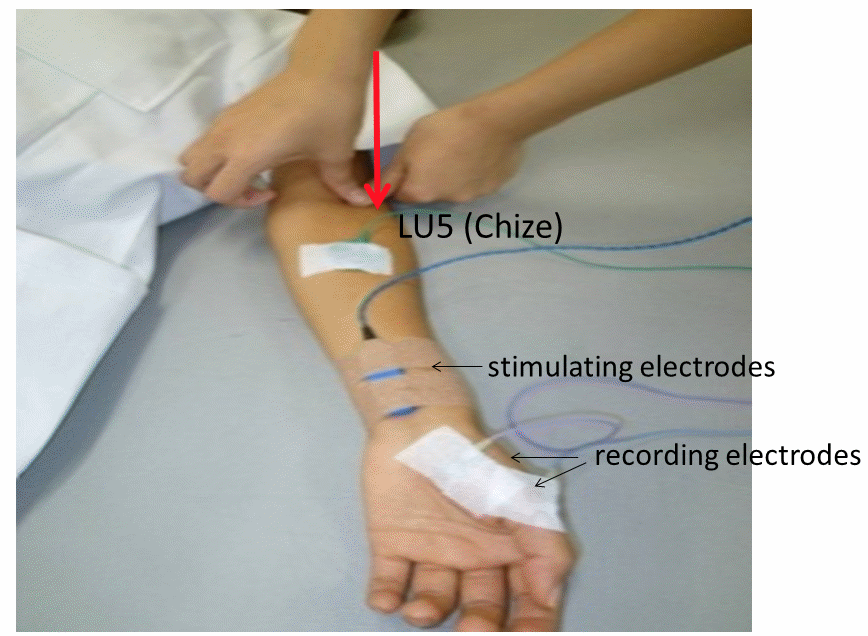
Figure 3 Inhibitory ASPT method used in this study.
The F-waves measured in 30 trials were analyzed with respect to persistence, amplitude ratio of F/M, and latency. Persistence was defined by the number of measurable F-wave responses divided by 30 trials of supramaximal stimulation. The amplitude ratio of F/M was defined as the mean amplitude of all responses divided by the amplitude of the M-wave. Latency was defined as the mean latency from the time of stimulation to the onset of a measurable F-wave.
Results
The amplitude ratio of F/M decreased gradually during and after ASPT compared with that before ASPT (Figures 4,5,6). No significant differences in persistence and latency were found before, during, and after ASPT. Typical F-wave electromyographs for each case are shown in Figures 7,8,9.
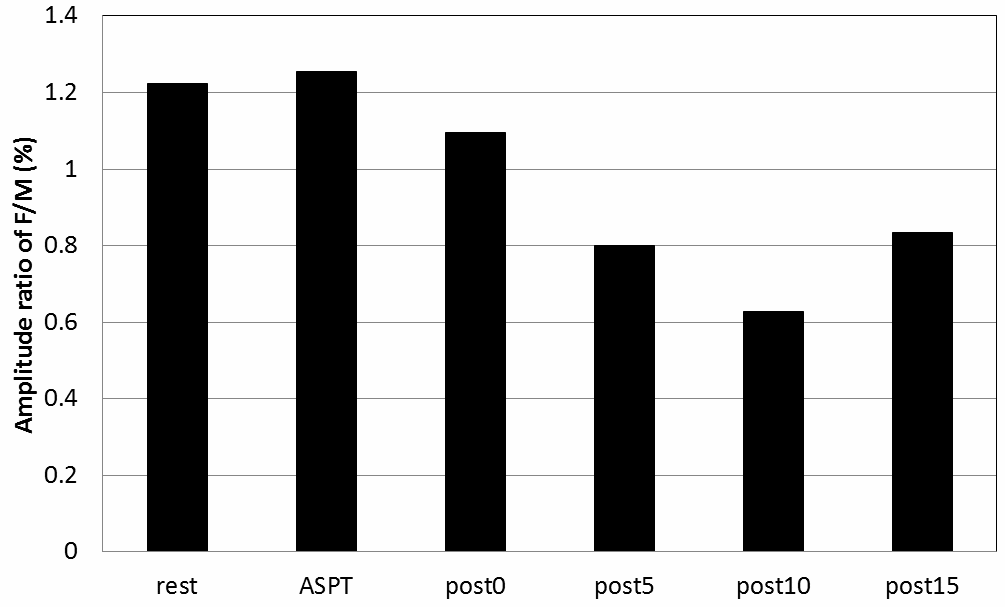
Note: The amplitude ratio of F/M decreased gradually during and after ASPT compared with that before ASPT.
Figure 4 Amplitude ratio of F/M by ASPT at LU5 (Chize) in a patient with cerebrovascular disease (CVD) (Case 1).
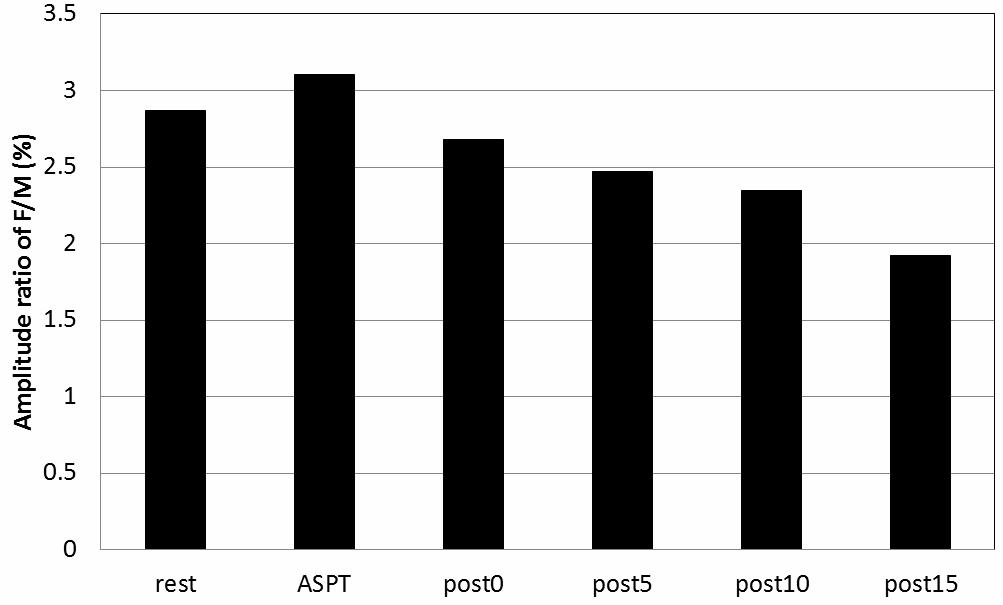
Note: The amplitude ratio of F/M decreased gradually during and after ASPT compared with that before ASPT.
Figure 5 Amplitude ratio of F/M by ASPT at LU5 (Chize) in a patient with CVD (Case 2).
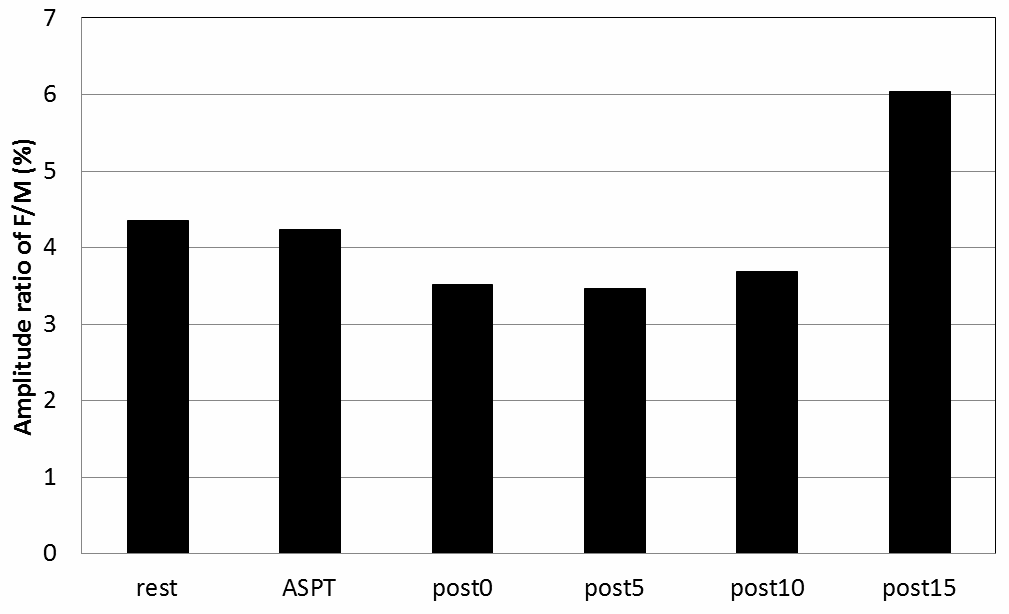
Note: The amplitude ratio of F/M decreased gradually during and after ASPT compared with that before ASPT.
Figure 6 Amplitude ratio of F/M by ASPT at LU5 (Chize) in a patient with CVD (Case 3).
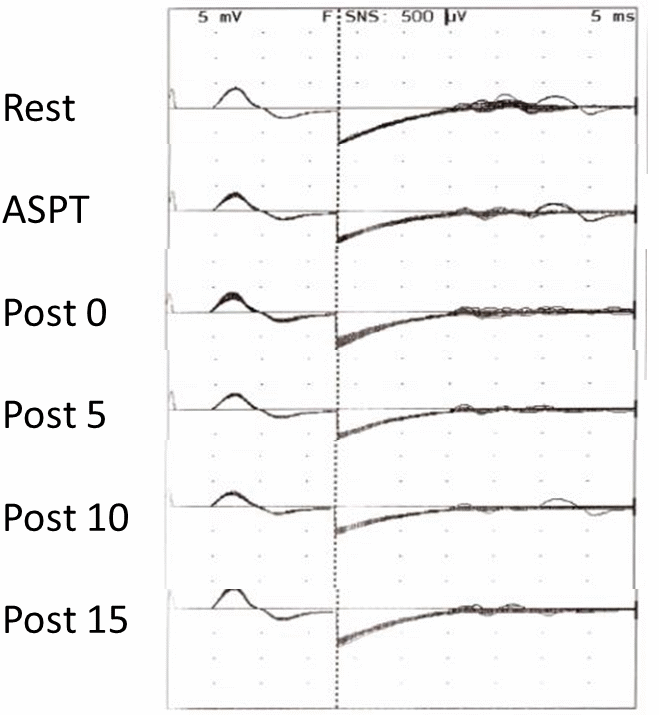
Figure 7 Typical F-wave at rest, during, and after ASPT (Case 1).
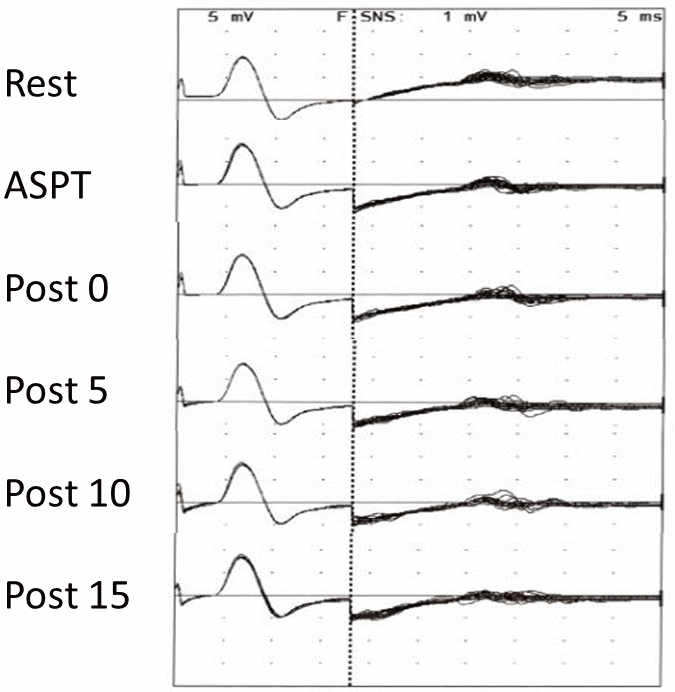
Figure 8 Typical F-wave at rest, during, and after ASPT (Case 2).
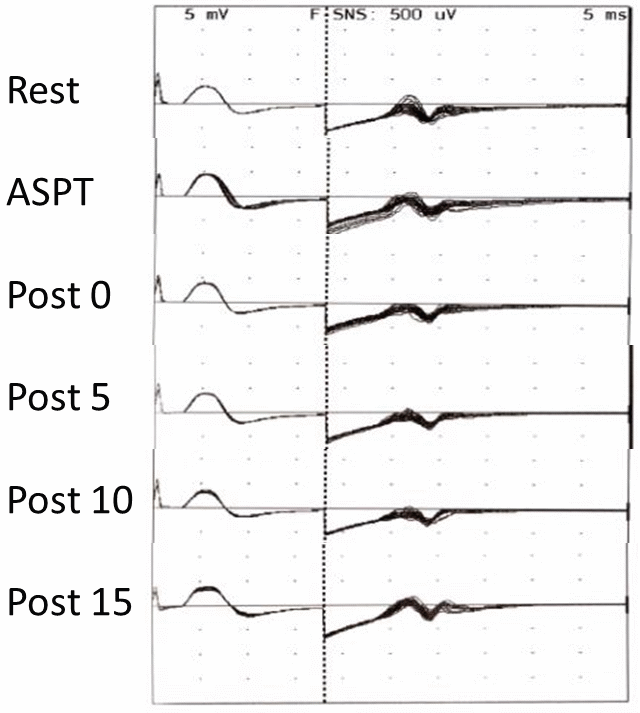
Figure 9 Typical F-wave at rest, during, and after ASPT (Case 3).
Discussion
In this preliminary study, patients had moderate hypertonia with different types of neurological findings and tendon hyperreflexia on the affected side, which was influenced by the excitability of the central neuron function and varied in each case. Case 3 showed severe hyperreflexia, while Case 2 was moderate, and Case 1 was mild with hyperexcitability of the central neuron function.
The F-wave is a result of backfiring of α-motoneurons following an antidromic invasion of propagated impulses across the axon hillock [6]. Its occurrence reflects changes in the excitability of spinal motor neurons, as reported in patients with spasticity [7,8]. We investigated spinal neural functions by evaluating the F-wave in patients with cerebrovascular disease [8]. The persistence and amplitude ratio of F/M in patients with cerebrovascular disease were affected by the grade of muscle tonus, tendon reflex, or voluntary movement. Eisen and Odusote demonstrated that persistence depends on the number of neuromuscular units activated, and the amplitude ratio of F/M depends on their excitability [9]. In their study, neurological tests for muscle tonus, tendon reflex, and voluntary movement revealed that the F-wave was influenced by the treatment.
In this study, we investigated the effects of the inhibitory ASPT method in patients with hypertonia and hyperreflexia caused by cerebrovascular diseases by observing F-waves as indicators of a change (in this case, a decrease) in muscle tonus. The resulting amplitude ratio of F/M following the application of ASPT at LU5 (Chize) on the affected side showed decreased excitability of spinal neural functions for the thenar muscle with several types of hyperreflexia.
These results can be explained by a combination of neurophysiology and Traditional Oriental medicine concepts. The LU5 (Chize) region is controlled by the C6 area at the dermatome level, and the thenar muscles are also controlled by the same C6 area. Vertical stimulation of the C6 area at the dermatome level inhibited the function of the primary sensory area, primary motor area, and spinal neural functions of the C6 area.
In Traditional Oriental medicine, vertical stimulation of acupoints inhibits the function of the meridian and the energy of related muscles. In our study, vertical stimulation of LU5 (Chize) inhibited the functions of the meridian and tonus of the related thenar muscles.
Thus, we suggest that the inhibitory ASPT method effectively decreases muscle tonus in patients with cerebrovascular disease. In Cases 1 and 3, the amplitude ratio of F/M was recovered at 15 min following ASPT at LU5 (Chize). It is difficult that Inhibition ASPT on LU5 (Chize) may continue inhibitory effect for a long time.
Conclusion
The application of inhibitory ASPT at LU5 (Chize) is implicated as a therapeutic approach that decreases muscle tonus in patients with moderate muscle hypertonia of the thenar muscle on the affected side that is secondary to cerebrovascular disease.
Author Contributions
Dr. Suzuki and Dr. Tani were established ASPT and tested the F-wave by ASPT for neurological disorders. Mr. Takamori and Ms. Yamada were especially tested the F-wave by ASPT for hemiplegic patients with cerebroovascular disease. Data of this research was mainly analyzed by Dr. Tani.
Competing Interests
The authors have declared that no competing interests exist.
References
- Suzuki T, Tani M, Nabeta R, Wakayama I, Yase Y. Evaluations clinique et electromyographique de l’effet de l’acupuncture sur les patients souffrants de torticolis spasmodique. Meridiens. 2000;115:17-26. (French)
- Ha-Kawa SK, Yoshida T, Yague T, Tani M, Suzuki T, Sawada S. Acupuncture-induced cerebral blood flow responses in dystonia. Ann Nucl Med. 2006;20:83-7. [CrossRef] [CrossRef]
- Tani M, Takada A, Inoue H, Suzuki T, Wakayama I, Yoshida S, et al. Acupuncture for Cervical Dystonia. KAIM. 2006;1:13-8.
- Tani M, Suzuki T, Takada A, Yagyu T, Kinoshita T. The acupuncture treatment of severe axial dystonia. J Chin Med. 2008;87:5-8.
- Suzuki T, Tani M, Onigata C, Bunnno Y, Yoshida S. Combination of physical and acupuncture therapy: acupoint stimulation physical therapy (ASPT). Int J Integr Med. 2013;1:115-8. [CrossRef] [CrossRef]
- Kimura J. F-wave velocity in the central segment of the median and ulnar nerves. A study in normal subjects and in patients with Charcot-Marie-Tooth disease. Neurology. 1974;24:539-46. [CrossRef] [CrossRef]
- Odusote K, Eisen A. An electrophysiological quantitation of the cubital tunnel syndrome. Can J Neurol Sci. 1979;6:403-10. [CrossRef] [CrossRef]
- Suzuki T, Fujiwara T, Takeda I. Characteristics of F-wave during relaxation in patients with CVD. PT Journal. 1993;27:277-81. (Japanese)
- Eisen A, Odusote K. Amplitude of the F-wave: A potential means of documenting spasticity. Neurology. 1979;29:1306-9. [CrossRef] [CrossRef]


